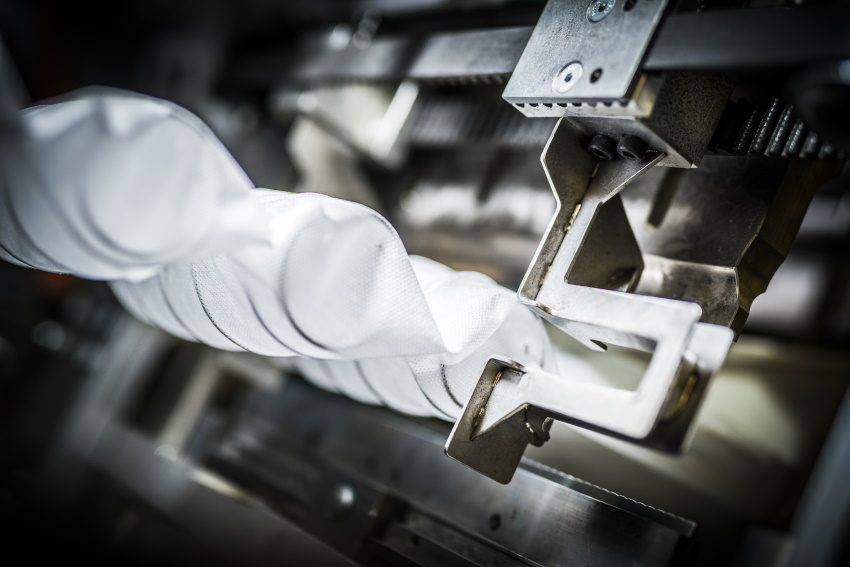You’ve made your bed, now you have to lie in it – and if you’re lying on a mattress from Spühl, you’ll have the best sleep of your life! The company based in Wittenbach, Switzerland, has made huge strides in the quality of its design data and uses big-data analysis in DOCUFY CAx Analytics to resolve problems and optimise processes. The manufacturer of wire forming machines has a soft and comfortable – or rather efficient and high-quality – basis for its future.
Millions of people rest, sleep or sit on wire-formed furniture built using Spühl machinery every single day. Put another way, Spühl GmbH is crucial in ensuring that people all over the world can relax. Mattress and wire-formed furniture manufacturers in more than 150 countries rely on the company’s products and, as an innovative business, Spühl invests up to 10% of its turnover in research and development.
Spühl GmbH was founded in 1877 and takes great pride in its Swiss roots. As a globally active machine-building company, Spühl offers technical expertise, continuous innovation, stable and streamlined processes and an extraordinary commitment to sustainability. The company is part of the Leggett & Platt (L&P) Inc. Group based in the United States. It develops and produces high-performance wire forming machinery, which is used throughout the Group’s global operations, with the customary Swiss quality and precision. Through its Fides brand, Spühl markets wire forming machines to the broader market, while Spühl Production Services SPS operates as an outsourcing partner for many niche SMEs in the mechanical and apparatus engineering sector.

CAD data chaos following migration to Siemens NX
Marko Djordjevic is PLM/CAx Systems Analyst at Spühl GmbH. Over the past four years, Djordjevic and his team have been making use of the DOCUFY Quality Manager to optimise CAD data quality and DOCUFY CAx Analytics software to analyse design data and – with each of the 11 machine variants produced each year consisting of some 10,000 parts – increase quality, reduce errors and save costs. “We were in need of a data quality and analysis solution because our data was not available in sufficient quality following the introduction of Siemens NX as a new CAD system,” says Djordjevic. “This was extremely problematic in terms of a consistent system environment and caused all manner of issues, including software crashes, non-compliance with directives and uncontrolled data accumulation.
We opted for the 90-day test licence for DOCUFY Quality Manager (DQM) in November 2017 and began analysing our data pool and pinpointing potential for optimisation, particularly with the analysis tool (DCA). After the three months with the test licence, we moved seamlessly into full operations.”
Marko Djordjevic, PLM/CAx Systems Analyst, Spühl GmbH
DQM and DCA: data assistances directly embedded into Siemens NX
The DOCUFY CAx Analytics (DCA) software assesses the design data (2D or 3D models, drawings, components) from the CAD program Siemens NX and provides the tools necessary to analyse this data simply and efficiently. The results are prepared in the form of descriptive analysis, providing insight into potential for improvements and cost savings. Just like DOCUFY CAx Quality Manager (DQM), DCA is directly embedded into the Siemens NX software and quick and easy to use. Manufacturing companies use DCA to streamline their processes, as a basis for key decisions and to identify potential cost-cutting measures, which saves valuable time and money. Spühl GmbH is no different: A design team of around 25 to 30 people already use the software, as do a further eight employees in production. “The best thing about the analysis tool is that 90% of the checks we require come as standard,” says Djordjevic. “We only had to arrange a further two or three important checks to be programmed for us. This was a huge help when we began working with the system. The tool is simple to use and able to be configured without any special programming knowledge.”

Cross-division data quality is vital to automation
Without cross-divisional data quality, high levels of automation will result in constant error messages and poor results. At Spühl, design data is also used for CAM programming, assembly and the spare parts catalogue – making consistent and high data quality a must-have. “We have successfully enhanced our level of standardisation by using DCA,” says Djordjevic. “We now suffer less disruption and are able to meet our deadlines with no stress whatsoever. In the past, if a machine returned an error in assembly, a huge amount of time was lost and the design team would have to eliminate the issue before we could move on. The story was repeated with each additional error, costing us time, money and a whole lot of stress. The rule of ten (see chart below) in quality assurance certainly applies to us – so the earlier we discover and eliminate an error, the less expensive it is for the company.”

DOCUFY CAx Analytics is effective in somewhat unexpected areas, too: procurement can also use data analysis to gain vital insight. Spühl took a closer look at the materials it uses and the bore sizes of its machine parts, brought them up to new standards and minimised the range of different tools required in production as a result.
“If you take a look at the potential for savings, it very quickly becomes clear that this software pays for itself in a very short space of time.”
ROI on the use of DQM/DCA
Spühl GmbH prepared an ROI calculation in 2018 to justify the purchase of the software. Spühl programmes some 680 orders per year, some 10% of which contain errors. On average, it takes four hours to correct each error. In addition, external data also has to be reprogrammed. It’s the same story with small parts, where 10% of 150 data sets are defective. One hour of correction is required for each data set. Data relating to motors and gears requires around five hours of processing. Spühl receives some 20 motors/gears per year.
When a new order is received, the DQM system also checks whether the necessary tools are available and shows any necessary changes to customer orders at an early stage of the order process, saving some EUR 20,000 in tool order costs per year. Erroneous order data means defective parts, something that can also be minimised by DQM, saving around EUR 9,500 in costs of materials for defective parts per year.
Away from the cost savings, machine quality and compliance with design and production directives is always a top priority, which is why big data analysis is carried out first, before a machine enters series production, to check whether the rules and regulations have been followed.
A question of mindset: assistance, not control
When introducing a new piece of software that detects and discovers errors, it is important to go about the integration process gradually with the greatest possible involvement of the users. After all, software is only as good as its level of acceptance among users. As a result, Spühl’s IT team rolled out the DOCUFY software in three phases, beginning with voluntary usage once the system was configured. Afterwards, the system was reviewed and users were asked for their feedback as to whether everything was working as they expected. Only then did use of the software become mandatory – something that was also reviewed. In the third and final phase, an error message from the system triggered an immediate stop to the approval process until the cause was located.
“It was vital to include employees in the project at a very early stage and keep key users updated on the project progress,” explains Djordjevic. “Early on, people were relatively sceptical about the use of DQM and DCA. Working with additional software took longer and was seen as a waste of time.
This attitude has completely reversed since then. Now, our users run a check on each individual part and enjoy using the software – which is no doubt down to the fact that the checks were written and programmed by users, for users. Employees often come to us with new ideas for further checks. That tells us that everyone has understood that the system assists and supports them in the best possible manner and that checks are there to improve our work and put the company on a profitable course, rather than to find errors and apportion blame.”
Conclusion: quality increased, errors eliminated, profitability enhanced
The verdict on the use of DOCUFY’s DQM and DCA software is positive across the board. Thanks to improved data quality in design and analysis of 2D and 3D models, drawings and components, Spühl has successfully identified potential for optimisation and made significant time and cost savings in the process. Employees like using the software and are delighted to see the quality of their work improve. “I would recommend that all Siemens NX users get their hands on these two tools,” says Djordjevic. “The 90-day test licence is the best way to try the solution out.”
Questions about the product?
We will be happy to answer your questions about DOCUFY CAx Analytics.
Alexander Bellm
Phone +49 951 20859-73
alexander.bellm@docufy.de






